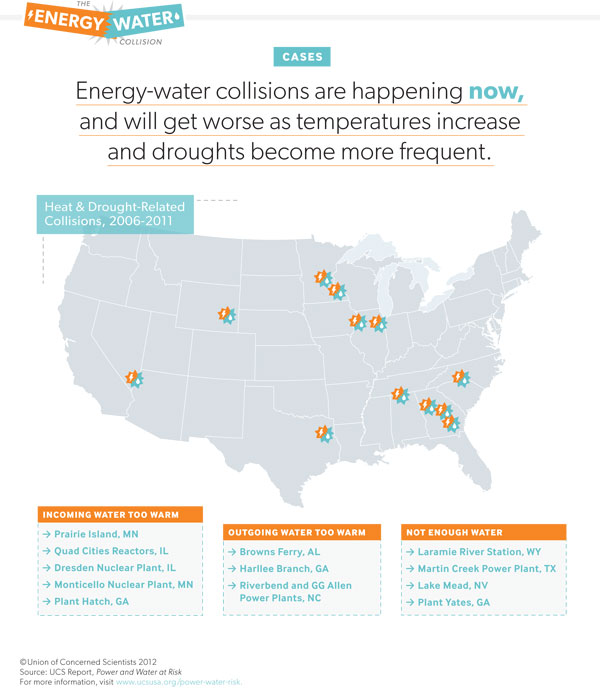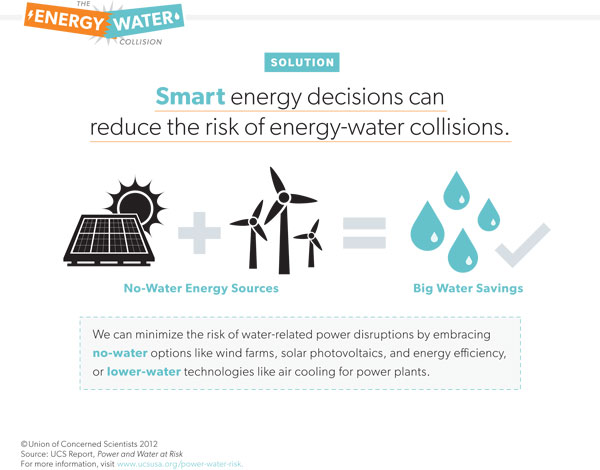The Complex Relationship and Looming Crisis Between Our Thirst For Water and Our Hunger for Energy
August 4th, 2012
Via The Union of Concerned Scientists, an interesting infographic and look at the watergy nexus:
We all need water. So when supplies dry up in the scorching heat of a summer like this one, we all — households, cities, farmers, industry, wildlife — can feel the strain. Among water users, power plants are some of those most dependent on a reliable supply. And when they can’t get enough, the plants and their customers can get caught in the squeeze.
It’s the heart of summer, 2012, and heat and drought are on our minds. No matter where in the U.S. you live, you’ve probably felt the searing temperatures, you’ve probably seen images of the withering corn crops, maybe the real thing, and there’s a good chance you’ve had your own water use restricted.
There’s good reason to see this summer as a taste of climate change, when what has felt like the future is coming home to roost in the present. If, as the science suggests, we can expect more drought and erratic rainfall, we have a challenge on our hands that we may not fully appreciate: Our power sector is built for a water-rich world, and when that world is water poor, power plants and electricity users face big risks. Brownouts and blackouts, for example, just when the power is needed most. These are risks we can and should be working to minimize.
Our new infographic series helps break down both the problem and opportunity.
First, our power sector is built for a water-rich world. Conventional fossil-fuel and nuclear power plants require water to cool the steam they generate to make electricity. In 2005, power plants accounted for over 40 percent of all freshwater withdrawn in the U.S. At some power plants, a lot of the water they withdraw gets evaporated in the cooling process; at others, much of the water is discharged back to its source (albeit hotter). The bottom line: Most power plants need a huge, steady supply of water to operate, and in hot dry summers, that water can become hard to secure.
The phrase “energy-water collision” refers to the range of issues that can crop up where our water resources and our power sector interact. In hot, dry summers, that problem takes three main forms, captured in the graphic below.
Here are some recent examples of each:
(1) Not enough water: Last year’s heat and drought in Texas caused water levels in Martin Creek Lake to drop so low that Luminant had to pump water from the Sabine River eight miles to cool its local coal-fired plant and keep it operating.
(2) Incoming water too warm: During a 2006 heat wave, incoming Mississippi River water became too hot to cool the two-unit Prairie Island, MN, nuclear plant, forcing the plant to reduce output by more than 50 percent.
(3) Outgoing water too warm: To prevent hot water from doing harm, e.g., to fish, power plants typically aren’t allowed to discharge cooling water above a certain temperature. When power plants bump up against those limits, they can be forced to dial back power production or shut down. Alabama’s Browns Ferry nuclear plant, on the Tennessee River, has done just that on several occasions in recent years – cutting its output three of the last five summers, for example, and for five consecutive weeks in 2010. Household electricity needs were met by other power generators, thankfully, but at higher prices.
As the map below captures, cases like these are cropping up across much of the country. Since it was finalized, just two weeks ago, there are at least four new cases to add to the map, including one in the Northeast.
So far this summer, several new “collisions” have involved plants seeking permit waivers to discharge water at higher temperatures. But counting on waivers as ambient temperatures rise will surely have its limits. To say nothing of the ecological impacts, power plants simply can’t use overly hot water to cool steam.
So where do we go from here?
Straight toward water-smart energy choices. And chief among those: low- and no-water energy choices that are also (given the climate connection) low-carbon.
Yes, this is another one of those instances in which energy efficiency and most renewables are just incredibly sensible choices. Not only do renewables like wind and solar PV require essentially no water to operate, thereby increasing the resilience of our electricity system to drought, but bringing more renewables on line (and increasing efficiency) would help to slow climate change and dampen the heat and drought trends we’re worried about.
If you’ve got the future in mind — whether you’re concerned about energy system resilience, water resources, or climate change – low-water renewables just make sense. Not all collisions are avoidable; thankfully, by grabbing the wheel and turning hard, we can steer away from this one.
This entry was posted on Saturday, August 4th, 2012 at 8:51 pm and is filed under Uncategorized. You can follow any responses to this entry through the RSS 2.0 feed. You can leave a response, or trackback from your own site.
Leave a Reply
You must be logged in to post a comment.
Educated at Yale University (Bachelor of Arts - History) and Harvard (Master in Public Policy - International Development), Monty Simus has held a lifelong interest in environmental and conservation issues, primarily as they relate to freshwater scarcity, renewable energy, and national park policy. Working from a water-scarce base in Las Vegas with his wife and son, he is the founder of Water Politics, an organization dedicated to the identification and analysis of geopolitical water issues arising from the world’s growing and vast water deficits, and is also a co-founder of SmartMarkets, an eco-preneurial venture that applies web 2.0 technology and online social networking innovations to motivate energy & water conservation. He previously worked for an independent power producer in Central Asia; co-authored an article appearing in the Summer 2010 issue of the Tulane Environmental Law Journal, titled: “The Water Ethic: The Inexorable Birth Of A Certain Alienable Right”; and authored an article appearing in the inaugural issue of Johns Hopkins University's Global Water Magazine in July 2010 titled: “H2Own: The Water Ethic and an Equitable Market for the Exchange of Individual Water Efficiency Credits.”



